Mary Fleming's Blog, page 7
September 11, 2021
Seasonal News
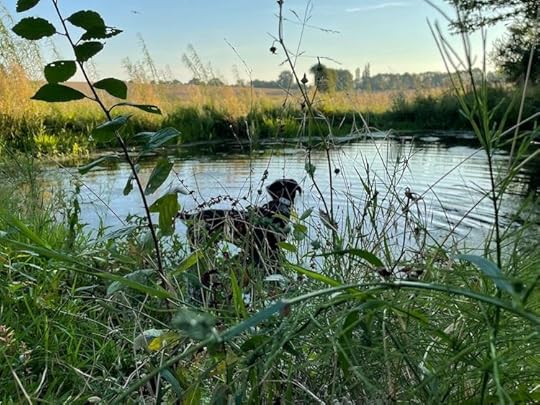
Friday, 10 September
In times as out of joint as ours, why wouldn't summer wait until September to appear? Certainly August here in the Perche showed scant sign of the season, being cool, often windy or rainy and not everything I cracked it up to be in terms of a quiet respite from the renovation works at our house. In fact, we probably only had about four days of peace. Workers kept showing up (we do not complain!).
But this first week of September and la rentrée for holiday makers and school children, the sun came out resolutely, the wind died down and the temperature rose to 30°C/86°F. The day after the first réunion de chantier, when the architects and artisans expressed confidence that the house will be done by the end of October, there was no one. Not a single worker, thus leading us to wonder how, exactly, they planned to make good on their claim. No matter what they say or who shows up, as a battle-scarred remodeller, I'm predicting a Christmas finale. If I'm wrong, hallelujah.
 Where have all the workers gone?
Where have all the workers gone?Anyway, it really did feel like summer. Mornings I sat working on my chaise longue, looking out the window through the gauzy light at the fields and forest, the only sounds a lazy chirp outside or David’s feet upstairs as he poured himself another cup of coffee in our temporary kitchen-dining room. It was pure bliss.
Friends from afar came to visit. Virginie for a couple of nights and Jacqueline for lunch, both linked - though unconnected with one another - to our Berlin life, a past chapter that friendships weave into our present. For the first time all year, we lingered outside after dinner, lit the candles as the sky darkened, watched the stars twinkle. With no intermeddling streetlights, it is a celestial feast.
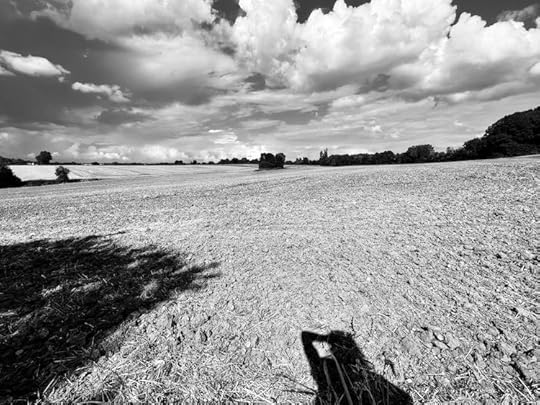
The lull didn’t last. Patrice and Vincent W came to prepare the organic-in-the-making soil for the winter alfalfa and clover, natural nitrate boosters that will help the farmland get fully certified as bio in two more years.
 Planes back on track
Planes back on trackIn another sign of autumn, the days are shrinking. I wake to a dark horizon, the sun only appearing as I set out on my walk with Tasha. A walk that has slowed considerably since the blackberries started ripening. For a long stretch, there is a wall of bushes and I can't help myself stopping and tugging at every plump possibility. Tasha, I have discovered, is a berry fan too.
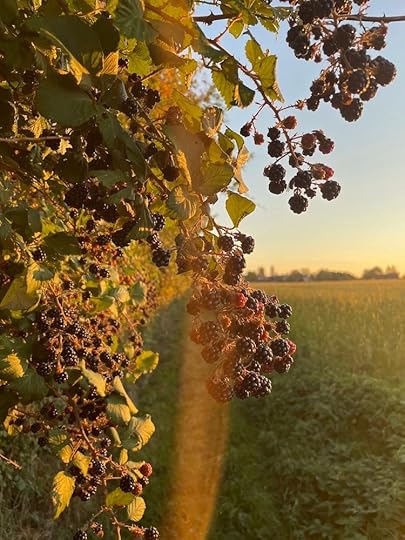
Pool workers began trickling back to put on the finishing touches. They also turned on the heat, meaning that David has tested the waters too and declared our cathédrale à la natation worth every centime.
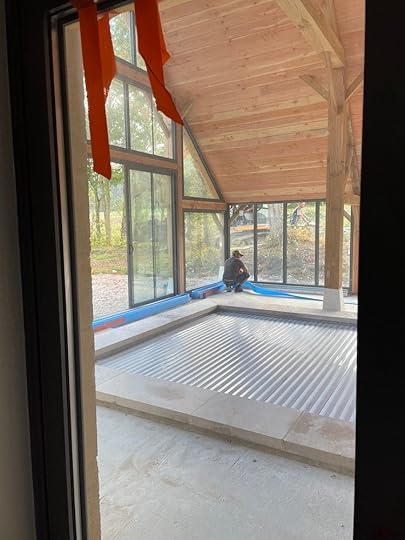
Yesterday the diggers, whom we haven't seen in many months, returned.
 Here they come
Here they comeThey will be getting back to the garden (David can relax). Much already overturned earth, covered with weeds and wild flowers during the rainy summer, will be re-churned and displaced these next days; it may soon be a mess again but only temporarily. It's time for the creative part of the destruction to take full shape.
 Our green guru Claire with Digger-in-Chief Monsieur C
Our green guru Claire with Digger-in-Chief Monsieur C Here we go
Here we goIt was a short but very sweet summer. And autumn looks promising.
 Thistles sending out their seed
Thistles sending out their seed
August 28, 2021
Confession

Friday, 27 August
In my many blog posts over the last year about the renovation of our property in the Perche, there is one element of the project that I have studiously avoided, both textually and visually. Rather like tiptoeing around the elephant in the room. And it is rather large, what I have been sidestepping.

As remodelling plans began to take shape, a question kept cropping up: What about a swimming pool? We certainly have the space. And there isn’t a lot to do down here at the end of the lane. A body of water big enough accommodate humans would expand the possibilities considerably.
 Shin deep and mucky
Shin deep and muckyIn the endless hours I spent poring over the Le Figaro property website while house hunting, I generally dismissed houses with pools, and certainly indoor ones. Partly because most of them were exceedingly ugly, but there was also a part of me that spurned the very concept. Am I, are we, swimming pool people? Neither of us has ever had one. Isn't it a little late to start now? Isn't it an extravagance we can live without?
 Good place to store some quince
Good place to store some quinceEspecially if you consider the poor planet. Building a large concrete basin for the amusement of a few lucky people and filling it with precious water that relies on chemicals for its equilibrium, is not ecological, however you slice it.
Then again, we said, swimming is really good for you. In fact, Google will tell you it cures just about every ill in the book:
• keeps your heart rate up but takes some of the impact stress off your body
• builds endurance, muscle strength and cardiovascular fitness
• helps you maintain a healthy weight, healthy heart and lungs
• tones muscles and builds strength
• provides an all-over body workout, as nearly all of your muscles are used during swimming.
Swimming has many other benefits including:
• being a relaxing and peaceful form of exercise
• alleviating stress
• improving coordination, balance and posture
• improving flexibility
• providing good low-impact therapy for some injuries and conditions
• providing a pleasant way to cool down on a hot day
There was a practical question too: If we were to indulge ourselves and build a pool, where would we put it? The many friends and family who visited that first prelapsarian (pre-Covid) summer of 2019 were full of ideas. In the field behind the two big Cyprus trees, with views on the rising and setting sun, said some. No, behind the boulangerie, which you can turn into a pool house, said others.

Too far from the house, said the architects. No one will use it. In any case, not one suggestion sat right with me aesthetically; each location seemed awkward, a blight on the beauty of Deux Champs.
For a long time, we'd finish the ongoing debate with: We don't have to decide right now. But during a réunion de chantier, with work on the barn well under way, Monsieur et Madame J, the architects, said indecision time was just about up.

We were standing behind the house, between the end of the wall and the tree you see in the above photo, discussing that corner of the garden as a possible site. Closer to the house - but maybe too close - it still didn’t seem the right spot. You also have to consider, they said, that pools in the Perche are only in use three to four months a year.
Okay, forget the pool, we started to say, when Monsieur pointed to the wooden farm structure you see from inside and out in the above photos: “Of course you could build a covered pool right here:”

He was certainly correct that, tucked in at the crook of the L formed by the out buildings and the barn/house, it would be a perfect fit. The idea of being able get exercise all year round was also hard to resist.
So in a matter of minutes, we’d gone from ‘no pool’ to let's build an indoor one (at considerably greater expense), with accordion windows around the sides that can be opened in summer.
 Muddy start
Muddy startWork began in February when we were in London. The frame was conserved and extended; the roof completely redone.

I watched from a distance...
 Drones-eye view
Drones-eye view...my conscience still troubled by this mega frill, but obviously not that troubled because on went the work.

...

...

...

...

A week ago, the water went in and so did I (with the temperature a bracing 18-19°C /65F, David's waiting for the heat to be hooked up).
 Cathédrale à la natation
Cathédrale à la natationEven without the heat and the stone floor that has yet to be laid, the results are, to my eye, spectacular, including from afar, where the roof peeks out at the back and mirrors the projection at the front (see top photo). In fact, all that’s really missing are the other hotel guests lounging around on deck chairs in thick white robes and bathing slippers.
And my conscience? Like with the ousting of the swallows, it gets more accommodating with each swim. The personal health benefits are, as advertised, multitudinous.
 The new aesthetic
The new aesthetic
August 14, 2021
Request Granted

Friday, 13 August
When I pushed ‘Publish’ two weeks ago, it was with a limp finger. I was not completely satisfied with the blog I’d just written and not happy with myself either.
Quiet, Please, seemed unfinished, missing a descriptive detail here, a clarifying thought there, but I pushed publish anyway to make the deadline for the Mailchimp subscribers (and without which I might still be fiddling with my first entry).

I also felt like a wimp. In the blog I complained about the renovations, chez nous in the Perche and next door in Paris. The racket and the presence of people were preventing me, I wrote, from thinking clearly and writing well. But wasn’t that just an excuse? Consumed by the creative fever, shouldn't I remain oblivious to hammers, saws, drills and radios, the odd bit of shouting? Wasn’t the problem essentially me, more a question of my flawed mind and weak will, than outside circumstances? Would August really change anything?
 Nothin' happenin'
Nothin' happenin'Especially since on the fiction front, matters were even worse. I had been hammering away at a novel project for months with zero progress. Though I was still getting up every morning before dawn, I'd trudge upstairs, make my coffee and settle on the sofa in David's office, then struggle during this usually preciously productive time to muster even a mild interest in my characters and story. Once back at it after the dog walk, the workers having arrived, my efforts proved even more futile. It was hard for me to believe I'd written one, much less three novels (the third is with my agent now).
 Tasha, conveying the mood in the room
Tasha, conveying the mood in the roomBut when the artisans in the Perche did finally leave on holiday, lo and behold, the din in my head stopped. The missing pieces of the blog landed in my brain, and I went about inserting them.
 Inspiration
InspirationI also talked to a friend who has recently shifted from writing screenplays and directing films to writing novels. He phones from time to time for technical and procedural advice. I know not why; his first novel, the one he started last year, will be coming out at la rentrée littéraire 2022, I learned. I mentioned my block to him, then mentioned it again later when relating the conversation to David, something I hadn't yet done because most of the time work remains in the confines of my head.

But David does know the basics of the story I am trying to tell, and in talking it through with him, I saw the way forward.
 Revelation
RevelationSince then, the dull dread that filled my being each morning has abated. I approach the day's work with renewed energy and hope. During the walk with Tasha, my mind simmers with ideas. I get back to it happily after breakfast in the continued quiet, with the additional satisfaction of feeling vindicated in my complaint.
We'll see how long the restored focus lasts, come September and the return of the workers. In the meantime, I hope the rest of you have found some inner summer calm too.
 Light at the end of the tunnel
Light at the end of the tunnel____________________
If you like these photos, there are lots more on my Instagram account, @flemingm6
July 31, 2021
Quiet, Please

Friday, 30 July
Incessant noise hews the mellow summer air and crushes the ability to think. In Paris yesterday, hands over my ears, I stared at our kitchen wall, expecting it to crumble at any minute under the deafening, juddering drilling from next door. In the Perche, the hammering and sawing, the workers' droning radio music come at me in stereo as, sandwiched in my temporary office, our bedroom, I try to write this blog or make progress on a new novel. I avoid the living room altogether because the dust collects as fast as it is removed. The disruption of renovations, ours and others, is beginning to seem a permanent state, our inescapable karma.
At least here in the Perche, after a long stretch of uninspiring changes—it’s hard to get excited about new pipes and electrical wiring—progress now sparks some enthusiasm when we open the door to the main house in the evening and inspect the day’s work.
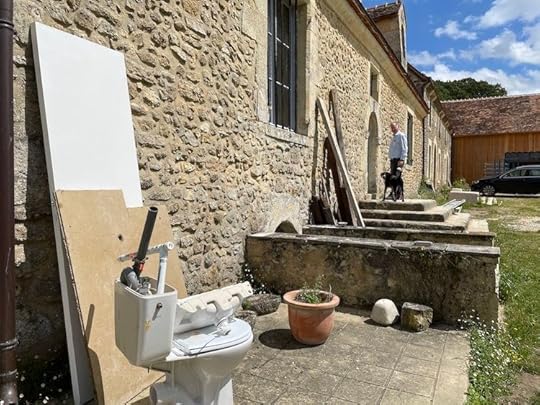
Most notably, the enduit, the characteristic sandy Perche coating that leaves a hint of stone apparent, has been applied to the walls in the entry...
 I approve
I approve...living room...
 So do I...I think...
So do I...I think......and kitchen...
 Yes. Very handsome.
Yes. Very handsome.Upstairs the new layout takes shape. Partition walls have gone up.
 Close your eyes and imagine an office
Close your eyes and imagine an officeFloors are being laid in the bathrooms.
 Cornered
CorneredBut as you can see, my new office will not be finding its feng shui any time soon, and no guests are going to be showering chez nous in the coming months.
Beyond the aural distress, there is the visual affront. Work sites are messy and ugly and not just inside, as you see above, but outside too. There is stuff everywhere, dissuading you from pottering around the garden, or even wanting to be in it...

...whilst blighting the view beyond it...
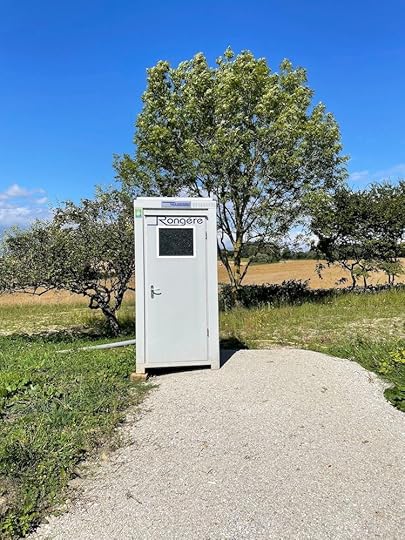
Fortunately, as it so often does, the natural world comes to the rescue. Unlike much of the planet (think 50°C/122°F in Vancouver), our swath of Europe has had an exceptionally kind summer. Temperatures have only risen above 30°C/86°F a couple of times. It has rained and rained some more. In contrast to last summer, the leaves are still on the trees in the Tuileries…

…and the countryside is an explosion of green.
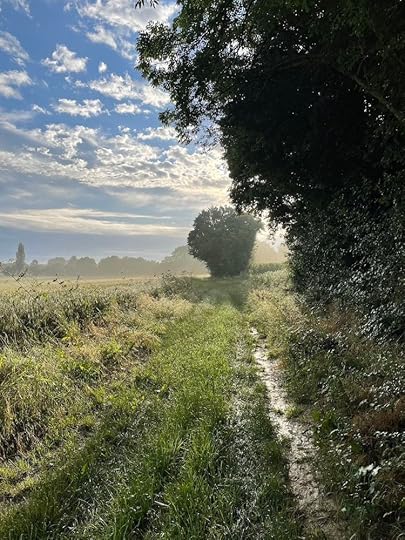
Our recently dredged pond is thriving.
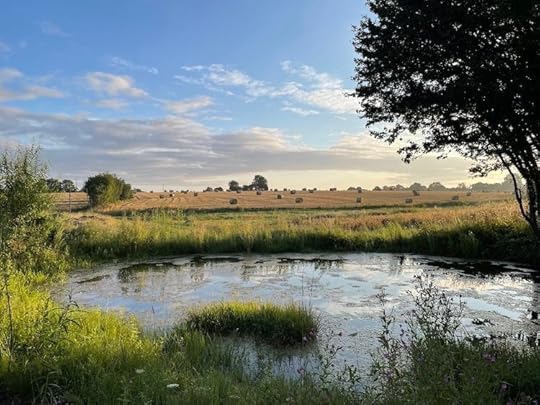
And forging ahead after Tasha on our morning walk, I dodge flowers and duck brambles that have poked their heads into the path.
 Wild carrot going wilder
Wild carrot going wilderI often stop at this field of sunflowers. In fact, I could hang out with these life-size Perchois all day, maybe make some new friends.
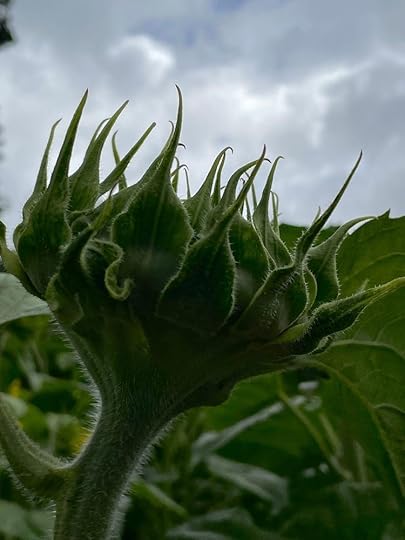
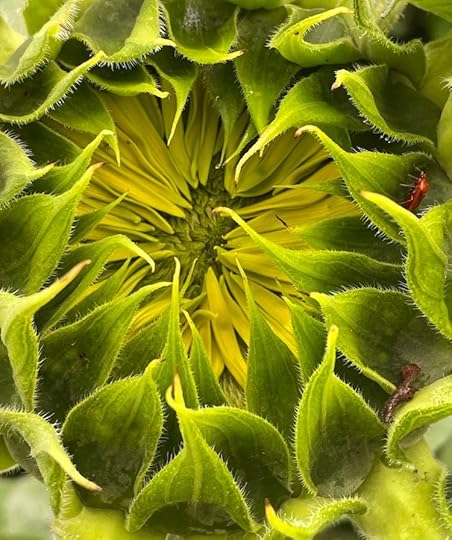
 Sunflower Central
Sunflower CentralLast week the wheat was harvested in the fields just beyond our property. It struck me this morning that I have been more fascinated than usual by the uncollected bales of hay. Balled up, tightly wound and spatially isolated, they are an apt backdrop for this second Covid summer.
 Making hay and socially distancing
Making hay and socially distancingThe angst I am feeling is not only due to the noise and unsightliness of the interminable building projects around me. With its Greek-ified variants spreading like the wildfires that are erupting around the globe, and the ever-changing restrictions imposed by governments in an attempt to control it, the virus creates its own inner din, a persistent thrum of uncertainty. Covid living too is beginning to seem like a permanent state.
Time to go hang out with the sunflowers for a while.
______________
If you like these photos, there are lots more on my Instagram account, @flemingm6
July 10, 2021
Grains of Sand
 Too many grains of sand
Too many grains of sandFriday, 8 July
William Blake may have been able to see a World in a Grain of Sand, but I need something a little bigger to encapsulate my Paris life, which last Saturday 3 July clocked in at 40 years, close to the Eternity evoked by the poet.
Les Jardins des Tuileries, it occurred to me yesterday morning on my daily walk with Tasha, are a better lens through which to view my larger Paris picture over the years. Just consider the frequency with which the city's oldest public gardens make their way into this blog.
My first memories pre-date residence. At 17, visiting with my family, I struck out on my own after our tour of the Louvre. Walking along the central allée on a sunny spring day, I felt grown up and liberated, until irksome men made me wish French class had taught something useful, like “Leave me alone” (FYI: Laissez-moi tranquille is the polite version). A few years later, I waited forlornly in the cold, dying light of a December day in front of the Jeu de Paume, casting my eye over the place de la Concorde for a friend who never showed up, thus leaving me at dusk on my own and looking for a place to stay.
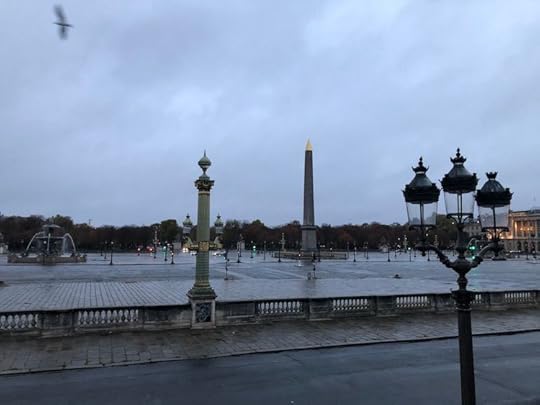
But my strongest associations with the gardens have been formed through my dogs. First with Lily, then Elsa and now Tasha, I have experienced the different seasons on a daily basis. Hot canicular days…
 Elsa endures
Elsa endures…and snowy wintery ones.
 Tasha endures
Tasha enduresDogs help you meet a fair sample of Homo Parisus. There are the people with whom you never get beyond a polite hello. There are the troubled ones you should have kept at a distance, the ones who start off with a perfectly nice puppy that they ruin by transferring their own problems onto the dog. And there are those who become friends, fixtures in your life: Nathaële (Youni, Colleen and Mousse), formerly an illustrator of children’s books, now a creator of animated videos; Nelly (Marou and Rêve) who actually worked for the Louvre, upon which the gardens depend, and who constantly defended canine rights for us within the administration; Stéphane (Urfée and Belle), a physical therapist; most recently Juan (Hope), a Cuban-American former antique dealer. And of course Koffi and Virginie (behind Tasha in the above photo), who saved our neurotic rescue dog and my sanity.
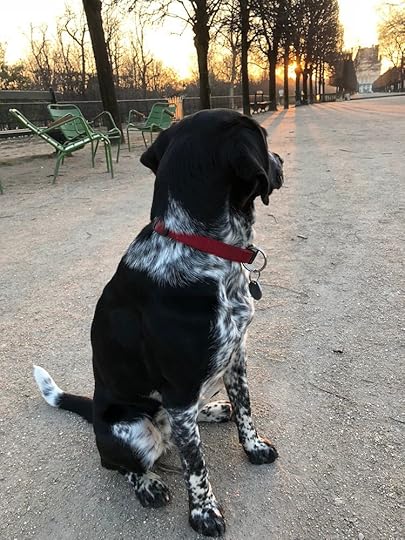
Through them I met a homeless woman I'd been seeing in the vicinity of the Seine for as long as I can remember. Her name is Lin and, loving dogs, she designated herself the Koffi & Cie water supplier.
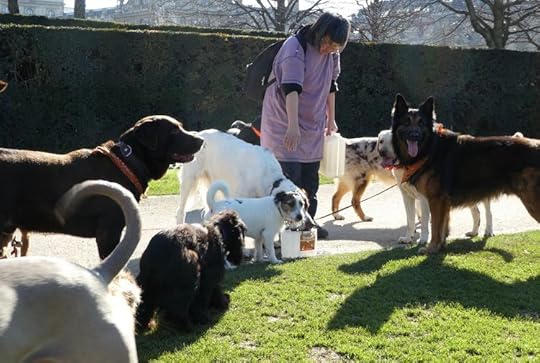
There is a constancy to the place, much as in the city herself, that reassures. The lines of trees and the fountains, the ubiquitous green chairs that tell stories all on their own...

...or in other instances, seem not to have changed occupants in 50 years...
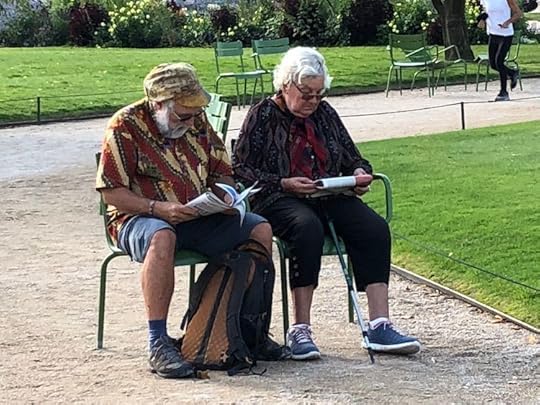
Parents still take their children to the Tuileries for entertainment, though no longer to the ponies that disappeared about 10 years ago.
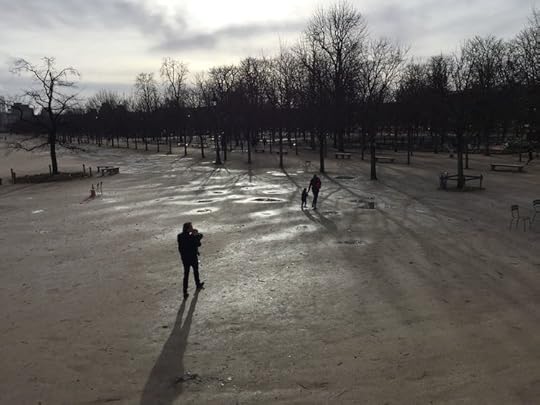
 Oops. Sorry, kids.
Oops. Sorry, kids.But in other ways the gardens have changed with the times. The most flagrant example is the evolution of Homo Parisus' relationship to physical activity.

Old-style Parisiens did not exercise at all, much less publicly and in ways that could expose them to ridicule. They did not dress in garish, sporty clothes. And, formerly a highly individualistic species, they would never have participated in group activities. But long gone are the early 80's when my only encounter during a lone, early morning run was with a hooded exhibitionist.
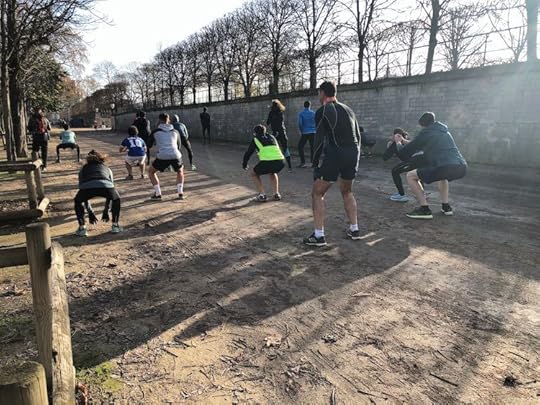
Even here amidst the trees, you can't forget our age of terrorism...

...or the fact that when it comes to the Self, we have perhaps gone a bit overboard...
 50% survival rate
50% survival rate...
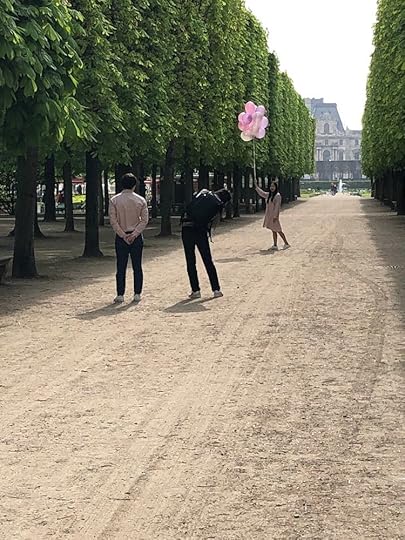
...thus leading to increased restrictions.
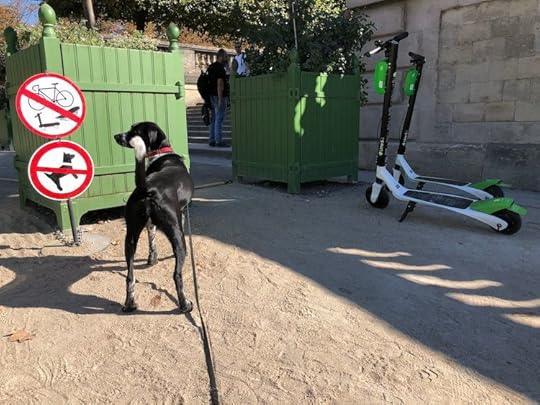
Climate change is nowhere better on display in the city than here (just look at the top photo of the dustbowl, the new April in Paris), but so too are our efforts, however small, to combat its effects.
 Hoping for higher than 50% survival
Hoping for higher than 50% survivalSo thank you, Tuileries, for 40 full years.
June 5, 2021
Deconstruction

Friday, 4 June
The last couple of months, we have been attentive observers at an archaeological dig. Or so it has often seemed, since the re-haul of our old house got underway early April.
Part One of our renovation project in the Perche transformed a 19th century barn into living space for humans; Part Two aims to bring the late 16th century seigneurie now connected to it into the 21st. Here is how an architect specialising in Perche monuments historiques imagined the c.1588 plan:

The tower you see to the right may not have existed (it is not shown on any of the early property register drawings), but the rest must be accurate because–except for the unconscionable removal of the spiral stone staircase, traces of which remain in the cellar–it's largely unchanged: an entry hall with a large sitting room to the right and a large kitchen-dining room to the left. Upstairs was originally a dovecote and later probably used for storing hay, though no one has been able to explain to me how the runic scratchings all over the door jamb fit into the picture.

Here’s his plan of the house that we bought:

The 19th century changes are marked in red: a couple of windows were added in the living room (the harsh-weather north-face would not have had any in 1588) and the arch to the 'tower' (quite possibly merely a humble latrine) was closed. A storage and furnace room replaced the bread oven behind the kitchen chimney. Upstairs, four small bedrooms and a bathroom were created, probably early 1980s.
Having commissioned a history of the house, we know quite a lot of its story. But deconstruction can still hold surprises.

The team of masons who so exquisitely metamorphosed the barn began to...

...upstairs, so the space can be remodelled into two bedrooms with baths. In pulling up the motley collection of flooring—some parquet here, some tiles there, with wall-to-wall carpeting covering the bedrooms—they discovered that the floor had been elevated by about 50 cm (20 inches) above the original.

Initially, our architect told us, the massive crossbeams would have stuck up like horse jumps along the tiled surface. The heightened floor would have been added when the space was revamped for human habitation.
Once the masons tore down the dry wall and the space began to resemble its first iteration, the house seemed to drift back in time. I could almost hear a pigeon cooing, see a farmer stepping over a beam to fork some hay. But it was when they got started removing the 20th century 'improvements' downstairs that the house's soul really felt released.
Post-Second World War, it was all the rage in France to cover up old stone (I won’t venture into the psychology of what that might say about the country's dubious conduct during the German Occupation) with newly minted material. Many houses–our former country house being a good example–had a plaster mix called crépi slapped on the exteriors. It was meant to protect from bad weather, but subsequent cracks often trapped rain and created more humidity. In any case, the treatment renders textured surfaces monotone and lifeless, and we removed as much of it as we could from our old mill house in the Eure. Here at Deux Champs the outside stone was spared, but inside some previous owner (the one who removed the stone staircase, I'd bet) smothered the walls of the entry hall and kitchen-dining room with a layer of cement thick as an overly iced cake, finishing off their work with curves I guess meant as aesthetic flourish.
 Creative touch
Creative touchDrilling the stuff off took three men several weeks.

Late afternoon, after they’d gone home, David and I would wander the rooms, examining their progress and admiring their work.

The liberated stone revealed quite a lot about the ur-house. In the above photo, top left over the stairs, you can see the lintel of the former opening between the entry and the living room, as imagined in the original plan. To the left of the stairs, a cupboard emerged, with indentations still in the stone where the shelves would have been slotted.
 "Okay, who took the shelves?"
"Okay, who took the shelves?"Next to that, in an alcove where we hung our coats, the masons uncovered a bricked-in door, also evident on the original plan, but who knew what shape it would be in once the cement and bricks were removed. The masons kept us in suspense, leaving it until last of the work on the kitchen side...

We watched them honing in on it, closer...

...and closer...until...

It was well worth the wait.
"Inespéré," said our architect. Besides being a work of art, it lights and lightens up the kitchen, lets the back part of the house breathe.
This project of ours is hardly Pompeii, but scraping away at what befell it during the 20th century has rivalled Netflix for us as entertainment during this most recent Covid confinement. It's also increased our sense of wonder and joy at the beauty and resilience of this old, old house down here at the end of the lane.

May 22, 2021
Lost Time

Friday, 22 May
Two days ago, I had a Proustian moment. The reverberating memory in my case did not involve a spongy cake; rather, it was conjured by a trip to the Préfecture de Paris.
For those of you unfamiliar with Marcel Proust's A la recherche du temps perdu (In Search of Lost Time), the narrator's eating of une madeleine opens a floodgate of sensations and memories from childhood, when Sunday mornings in the company of his aunt, he would dip the pastry into a cup of tea or tisane. The incident forms the cornerstone of the seven-volume novel.
Five years ago, the United Kingdom voted by a small majority to quit the European Union. Or I should say, half of the now less united kingdom (England and Wales) voted Leave, while half (Scotland and Northern Ireland) solidly voted Remain. I shared my views on the referendum at the time.

The divorce has been long and painful. Its effects are finally trickling down to the kids, i.e., we, the people, including those of us (British nationality having come to me through my first husband Charles) who live abroad. Brexit means I am no longer part of the Union, and for the first time in 20 years, I need a resident’s card, rather than just my passport, to live in France.

It took me a while to wade into the bureaucratic swamp, partly because of our long trip to London, partly from form-a-phobia. But partly, too, from memories of obtaining my first carte de séjour in 1981. It was a madeleine moment that felt more residual nightmare than comforting tidbit of childhood. Like a bad dream, it revisits me in snatches.

The endless waiting, the chaotic jostling with other demandeurs and worst of all, the encounter with the bureaucrat behind the counter. He or she never looked you in the eye, not until the triumphant announcement that this chit or that photo was missing from your dossier and you’d have to come back, go through the whole demeaning process all over again. I remember wandering a warren of corridors in search of the copy machine or a Photomaton, much as I search for an exam room in my nocturnal torments. And all this with my then very hesitant French and as yet undeveloped muscle for handling cold, rude fonctionnaires.

Unsurprisingly, the memory of this traumatic event triggered angst and a strong desire to procrastinate. Finally, at the end of April, I plucked up my courage and opened the site to surprise number one: the on-line application was straightforward and painless (and I could correct errors without having to start a new paper form). Second surprise: just one week later I was invited to sign up for (rather than be assigned to, as in the old days) an in-person interview, where I would hand over my one (not four) photo and get fingerprinted.
The skies over Paris this last week have been changeable, threatening one minute...
 Brooding
Brooding...and bright the next...
 Enlightened
EnlightenedWednesday morning the first drops of another downpour began falling as I locked up my bike outside the police station, just as I'd done 40 years ago. A crowd was gathered at the door, and as I approached, a woman with an elderly man in tow cut right in front of me.
Here we go, I thought.
Then surprises number three and four: with my summons in hand, I was let through immediately. And at the metal detector, when the elderly man seemed to understand nothing that his guide or the police agent was saying or gesturing about taking off his belt and jacket, the official, instead of getting impatient and hostile, lowered his voice and said to the guide: “Don’t worry. I’ll pat him down.”
Surprises number five and six: I was directed with a smile to Salle 4 and was received by another cheery, helpful face once I arrived. “Please sit down until your number is called, Madame Fleming.”
 "Welcome to the Asia and Oceania room"
"Welcome to the Asia and Oceania room"I kept expecting something very unpleasant to happen, but after a minimal wait (surprise number seven), the agent at counter B11 was charm itself. He even bent the rules and told me, without my asking, to keep my long expired carte de séjour, as if he'd divined my penchant for nostalgia. At the end he looked me straight in the eye with a smile: “You'll receive your card by post in the next two months. Do you have any questions?”
The sun was emerging from another shower when I walked outside, feeling both soothed and confused by the gentle, civilised interview. It wasn’t just the attitude that had altered so dramatically. It was also the faces themselves. The agent and most of the other employees I encountered during my blissfully short visit to the police station were people whose parents would have been waiting in the room with me 40 years ago (and getting an even more hostile reception than I did). So often accused of being unable to integrate, these children of immigrants are doing a much better job at the Préfecture de Paris than their all-white predecessors.
Lest I should think the country had transformed unrecognisably, demonstrators for better housing were lined up outside as a reminder that some things in France never change.
 Public service
Public serviceIn my bureaucratic angst, I'd forgotten Wednesday was also the day cafés were re-opening. Unlocking my bicycle, I got another Proustian jolt at these waiters in their penguin suits taking their own coffee break. It seemed a life-time ago that these creatures were last spotted.
 They need a break too
They need a break tooTime was all a jumble as I made my way home, past more crowded cafés and the bizarre sight of police policing police who were protesting attacks on fellow officers.
 Communicating
CommunicatingWhile the city's coming alive again is uplifting, it also seems, at the moment, as strange as her recent comatose state.
Mid-writing this morning, I went to pick up my bicycle from an overdue tune-up. The bike wasn't ready, so I passed the time on a café terrace, still thinking about my first days in Paris and how 40 years could simultaneously seem like yesterday and part of another life.
 An almost madeleine moment
An almost madeleine momentI am a huge Proust fan and as any regular reader of this blog knows, a fervent believer in the vital role that the 'immense edifice of memory' plays in our lives. But sometimes I have to wonder how much it can help, when the present seems so confounding.
 My corner café
My corner café_____________
If you like these photos there are lots more on my Instagram account, @flemingm6
May 8, 2021
Semi-Detached

Friday, 7 May
Recently I watched the new film version of Rebecca on Netflix. Based on Daphne du Maurier's 1938 novel, it's the story of a young woman who becomes the second wife of the wealthy Max de Winter after his first, apparently beloved wife's tragic death. Rebecca may have died but her spirit lives on, creepily permeating every aspect of the new Mrs de Winter's world.
Unfortunately, the 2020 movie didn't capture for me the eerie ambiance of either the book or the first celluloid rendition by Alfred Hitchcock and starring Laurence Olivier and Joan Fontaine. But I was reminded how the famous first line: “Last night I dreamt I went to Manderley again…” magically evokes a lost past and questionable reality.
On Tuesday, with intra-France travel now permitted under the latest Covid restrictions, we returned to Paris for the first time in five weeks. Combined with our London sojourn and other extended periods spent at our house in the Perche, it seemed we’d been away for much longer.
In fact, it felt as it did when we'd return from Berlin after several months absence. Driving down streets that are intimately familiar but not recently travelled, opening the front door to an apartment where five children were raised but is now curiously hushed and empty, I always feel semi-detached from my own life. Like the unnamed narrator of Rebecca returning to Manderley in a dream.
Quickly, however, alienation gives way to a burst of euphoria. This is home after all, with its familiar smell and trove of memories. It is also, especially since the post-five children renovation three years ago, extremely comfortable.

I happily rediscover my Paris routine, most notably my morning walks in the Tuileries with Tasha, even if the rigid geometry, after months in let-it-be nature places like Berlin and the Perche, can come as a shock to the canine...

...and human systems alike...

On some level, Paris is still Paris.
 May in Paris
May in ParisBut in many other ways these days, she is not herself. With closed shops and cafés and a 6pm curfew, Covid Paris just gets stranger; more of her soul seems to have drained away every time I return. At moments she practically echoes.
 Quai traffic, rive droite
Quai traffic, rive droiteMy son William, who himself moved to Arles last year, says lots of people his age have gone to Bordeaux or Marseille. My dog-walking friend Nathaële, affirming my perception, says: “You get used it. It means there’s less hostility and aggression.” But less energy, too.
Except, bizarrely, when it comes to construction. Not just the bike lanes the mayor continues to build obsessively, but also major renovations of buildings. Within 100 metres of us, for example, there are three huge projects. Across the street, the former Ministry of Defence is being turned into social housing and an activity centre. Around the corner, the former Socialist Party headquarters, first bought by shopping mall developers for their main office and - not surprisingly since no one is shopping anymore - sold mid-renovation to perfume makers, currently looks as if a bomb went off inside.
Even closer to home, the hôtel particulier to which our building is attached is undergoing an overhaul that makes our Perche renovation look like mere window dressing. Here's the before view of our courtyard...
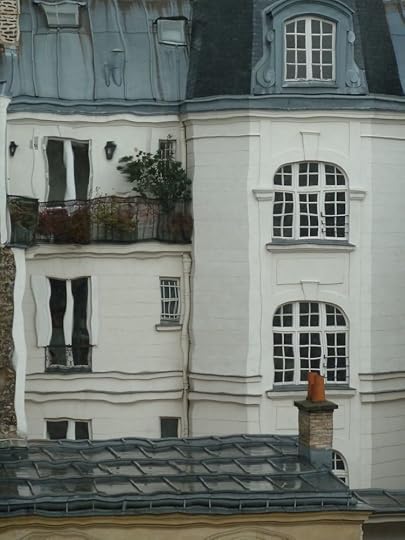
And here it is today..

The entire building has been clad in scaffolding, then wrapped in white plastic. Caught in the right light, the sheath can have a certain post-modern aesthetic...
 Ceci n'est pas un Christo
Ceci n'est pas un ChristoBut mostly...
 Meditative moment
Meditative moment...it has ruined our view...
 So much for the Paris skyline
So much for the Paris skyline...while doing nothing to reduce the noise of the drills, hammers and saws that easily outdoes the daily cacophony of our works in the Perche.
Renovation projects, it seems, follow us wherever we go. But the ones surrounding us in Paris at the moment add to the already surreal atmosphere. I mean, isn't it an odd time to be doubling down on the city's future?
 Bad bet or creative destruction?
Bad bet or creative destruction?Spoiler alert: it doesn't end well for Manderley.
April 24, 2021
Nesting

Friday, 23 April
I’ve been thinking about the swallows.
As regular readers know, we displaced a large family of them when we began to convert a barn into living space last year out here in the Perche. Before the works started, while we were locked down last April, David opened a hay loft and stall for their use. His timing was impeccable: several swallows arrived that very day and made a home at Deux Champs for the spring and summer. We happily cohabitated with the darting, disputatious creatures until August 19th, the exact same date as the previous year, when they invited every swallow in the area to a crazy evening rave party and were gone the next morning.
We wanted a longer-term solution for their housing, however, and our green guru Claire put us in touch with the local ornithologist Valentin V. We considered a prefabricated structure specially designed for swallows, but there wasn’t an obvious place to put it and Valentin said they were not always to the birds' liking anyway. Instead we opted for improving the hayloft habitat. Swallows build their nests where there’s a right angle, so we got the carpenters who are fashioning our windows, doors and bookshelves to hammer overhanging boards onto the crossbeams in the hayloft, thus providing the optimal 90° nesting conditions. As for the barn owl who’d moved in, we hoped he had found other accommodations.

These last weeks we’ve been looking at the blue, blue sky but haven’t seen a single swallow. It’s possible we’ve been too distracted by what’s going on in their ur-home to pay proper attention. Though we have now completely moved into the former barn so that work on the main house can get started, the list of ‘final touches’ never seems to end. Currently the place has rather the same buzz it had when the swallows were in residence. Carpenters, plumbers and electricians swoop in and out from their vehicles in the courtyard, while David and I flit around trying to find a temporary perch. Perhaps it’s too much activity for the swallows as well.
 Frosties
FrostiesI’ve also wondered if weather conditions haven’t played a role. With temperatures freezing at night and chilly during the day, maybe the swallows haven’t made it this far north yet. Or maybe they have been deterred by the extreme dryness. Our only April shower was weeks ago, and the clay soil is by now cracked and oven-proof hard. How could a swallow make her mud nest with that?
 Swallow Art
Swallow ArtValentin says we shouldn’t give up hope. Swallows are persistent creatures and may put us on their house-hunting list again next year.
Meanwhile, having our nest under siege is a challenge I am not handling well. I walk here and there, mask on my face and computer and notebooks in hand, settling somewhere until the noise stifles all thought or a worker pops his head around the door. My squawking at this state of affairs once the workers have gone home beats the most exercised swallow's trill by several decibels. Of course as renovation veterans, we knew how it would be. That's why we'd intended to spend much of this phase in Paris. But Covid has botched yet another well-laid plan, and we are enduring Confinement, Season 3, where circulation is freer and germs are fewer than in the Capital.
We would have missed a lot, too, had we gone urban.
For example:
1. Morning at Deux Champs. Outside...
 Saplings
Saplings2. ...and in.
 Before the work begins
Before the work begins3. Claire and Estéban checking up on their work.
 Yes, the plessage and the trognes are doing nicely
Yes, the plessage and the trognes are doing nicely4. Tala's tulips and lizard hunting.

5. The exuberant flowering of our quince, recently freed from the shackles of nettles and scrub
 Quince Lib
Quince Lib6. Local environmentalists Estéban and Clara, François and Evelyne, Yvan but not Claire, who was in Paris, when they came to count the newts in our newly cleaned pond and the moths in our newly organic field.

7. An inspection of the construction site by a local grass snake.
 Can't quite read his thoughts on the project
Can't quite read his thoughts on the project8. The beginning of the Deconstruction Period in the main house (more on that soon).
 Looking for meaning
Looking for meaning9. Dusk at Deux Champs.

10. The view from the new window in David's office, where I am perched this early morning. As you can see, one member of the household has had no problem settling into a new nest.
 La princesse, bien chez elle
La princesse, bien chez elle
April 10, 2021
What About the Garden
 Before - 13 April 2019
Before - 13 April 2019Friday, 9 April
If our house weren’t at the end of the lane, we might have driven right by it. Such were the changes to its outward appearance when we recently returned from a long trip to London.
We had been warned. Claire, our green guru, was keeping us up-to-date on developments: the new driveway and parking area, the foundations for a terrace out back. She had sent us a drawing of what she planned to plant and where...
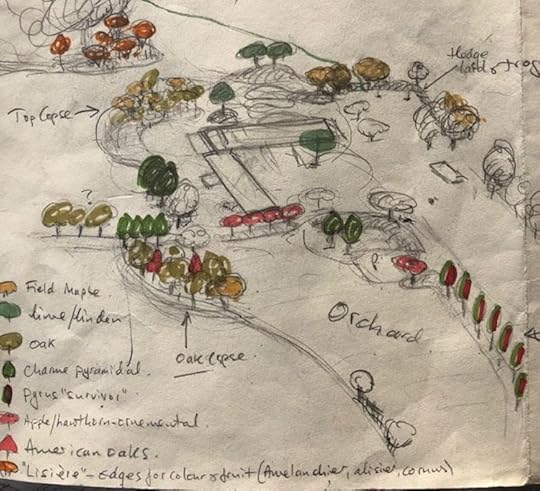
...and followed up with further details in emails...

But we were still surprised as we rounded the corner after a six-week absence. It was as if the house had been liberated from its hedgerow-scrub prison.
 After - 9 April 2021
After - 9 April 2021Granted the place has not yet really lost its Verdun look. No grass has been seeded after all the digging and churning of earth of the previous months and the land remains raw. Piles of soil, sand, wood chips and stone blot almost every vista. As noted in the email, lots of amputating has been going on.
 pollarded field elm
pollarded field elmAnd freezing temperatures have meant a later spring than the overly early one on display in the above 2019 photo.
At closer inspection, however, the bleakness holds much promise. The multiple plantings...
 Support system
Support system...as well as re-plantings, of hydrangeas and field maples, such as the amputee shown above, that once resided in the hedgerow.
Estéban, our agro-eco expert, pulled down barbed wire fencing, hacked away lots of scrub and cut back swathes of hedge that he then reworked via plessage (hedge-laying), a process whereby branches of trees are axed within inches of their life by a billhook, then bent and woven into a plaited hedge. They can be thus manipulated because the sap travels through the very outer layers of wood, just beyond the bark. The result is a work of live art.

Near our little pond, he also planted alder and willow to encourage the creation a mini-wetland area.

Recently dredged of suffocating cow dung that had been dumped there by farmers for decades, the pond is bouncing back to life with surprising speed. Estéban pointed out several patches of frog spawn. Then again with us humans on the scene, nature has no choice but to be resilient. Climate change is as apparent this spring as ever. Besides the freezing temperatures that have devastated crops across France, including up to 90% of some vineyards, there has been almost no rain.
 "I will survive!" sings the obstinate dandelion
"I will survive!" sings the obstinate dandelionWhen we bought this place in the Perche - two years ago next Monday - plans for the indoor renovation were already underway. After a Covid confinement delay, work began on transforming the cow barn into human habitation last June (fyi: recent reports of its completion were greatly exaggerated: workers have been buzzing about for the last two weeks, seriously disrupting our lives, and we're still waiting for a loo seat). Then last November we turned the 21 hectares (52 acres) of surrounding fields over to organic farmer Patrice W as a first step in a larger agro-eco project.
All the while my husband David has been asking: "What about the garden?"
Today I'd say Claire and Estéban have more than adequately answered that question.
 Saturday - a fine, firm April shower falls on Deux Champs
Saturday - a fine, firm April shower falls on Deux Champs



